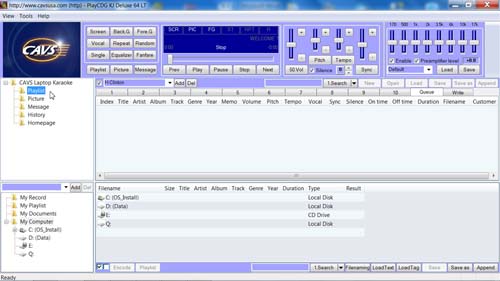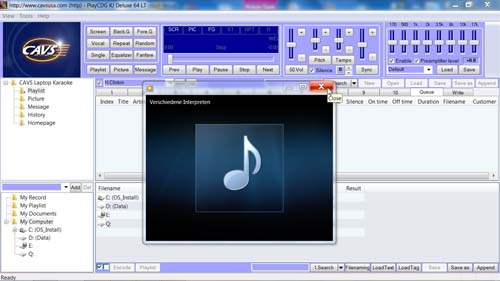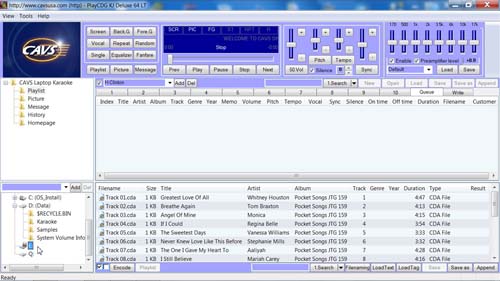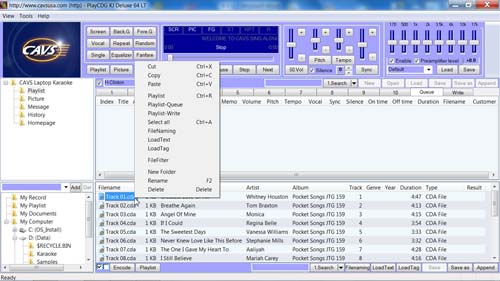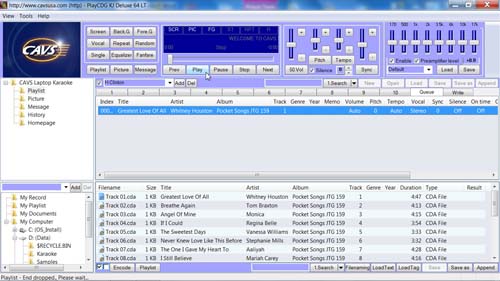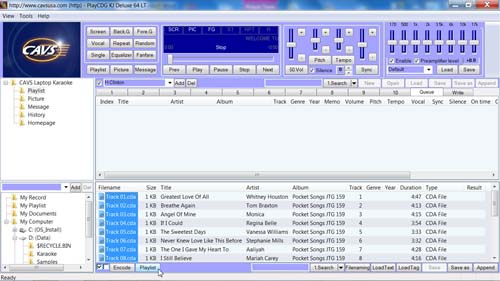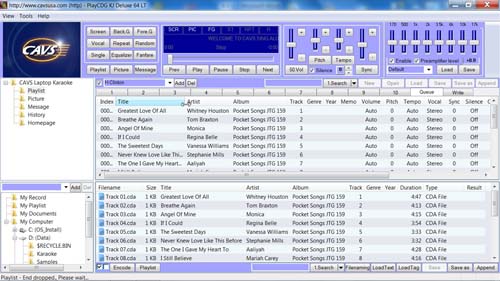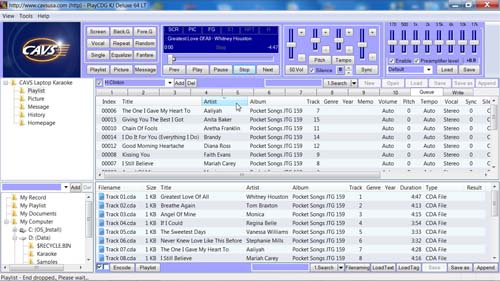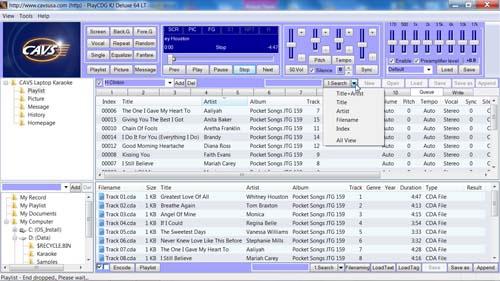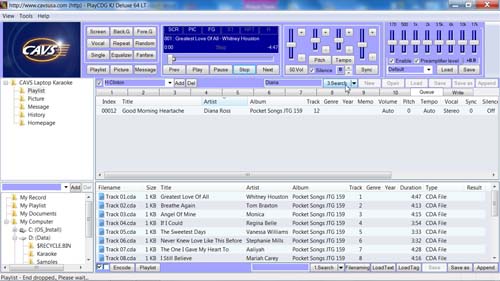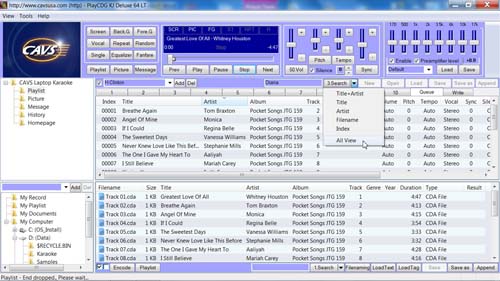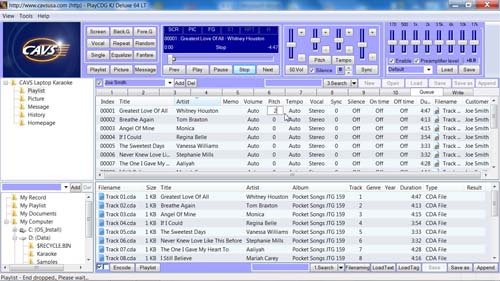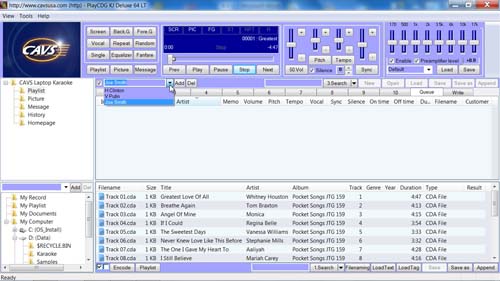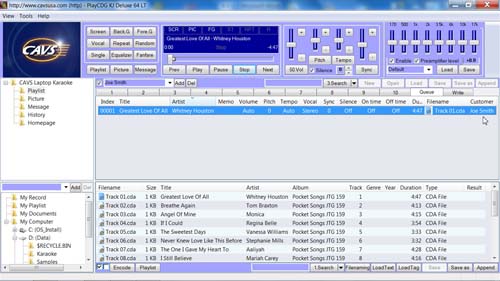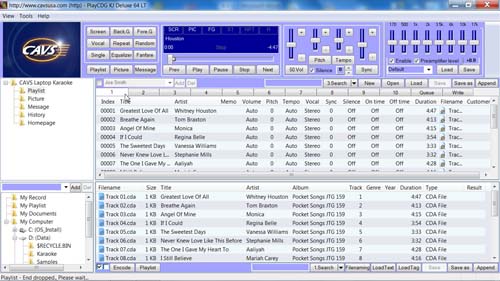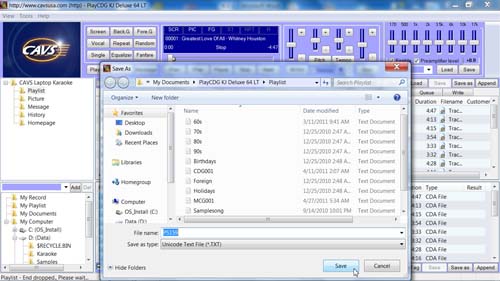How to play CD+G disc in PlayCDG KJ Deluxe 64 LT
1.
Start the PlayCDG KJ Deluxe 64 LT program.
2.
Insert the CD+G
disc into the disc drive of your laptop or PC. Close any pop-up windows such
as Window Media player shown below.
3.
Click on the disc drive
(in Folder Menu) and wait for the track information to appear on the right
(in File Browser).
Note that the title and artist information for each track has
already been added automatically from the online Internet database. Be sure to
have your laptop or PC connected to Internet to use this feature of adding
title and artist automatically from the online Internet database.
4.
Now you have the options to play the songs (tracks) directly from the disc
or first extract them into the hard drive and then play from the files. Here we will show you how to play the songs
(tracks) directly from the disc.
Right click on the song (track) you wish to play and select
Playlist-Queue to load the song into the Queue window above. You can also use
drag & drop to load the song into the Queue window.
5.
From the Queue window, click on the song and press Play (in the Control Panel)
to start playing. You can also
similarly load the song to any of the 10 Playlists or Write window above.
From a Playlist, you can click on the song and press Play (or double
click on the Index) to start playing.
6.
Songs in the disc can be loaded into the Queue, Playlists or Write window
all at once. Select the window into which you wish to load all the songs. In the example below, we select the Queue.
Click on the check mark at the bottom and press the Playlist button
as shown. You can also drag & drop the selected songs into the Queue window.
7.
In the Queue, Playlists or Write window, you can adjust the size of each
field by putting your mouse (cursor) in between the fields and press &
drag to the left or right. You
can also hide a field by right clicking on the field name and unchecking the
field name from the list.
8.
In the Queue, Playlists, or Write window, you can also sort the songs according
to Index, Title, or Artist by pressing on the field name as shown below. Click
on the field name again to reverse the order. This can also be done below in the File
Browser to sort the songs according to Filename, Title, or Artist.
9.
In the Queue or Playlists window, you can search for a song by Index, Title,
Artist, or Filename. Click on
the pull-down menu of Search and select the field(s) in which you wish to
conduct the search.
Next,
input the word or phrase that you are searching for and press Search. Only the songs that match your input
will show in the window below.
Note
that the Search function is also available below in the File Browser window.
10.
To return to view all songs in the Queue or Playlists window, click on the
pull-down menu of Search and select All View.
11.
In the Queue or Playlists window, you can preset various control values such
as Volume, Pitch, Tempo, Sync, Silence, On-time, and Off-time of the songs.
Double click on each field and input the following values:
Volume Volume
control (0 : 100)
Pitch Pitch
control (-11 : +11, half tone steps)
Tempo Tempo
control (-10 : +10)
Vocal Voice
cancel (Stere(0)/Left(1)/Right(2))
Sync Synchronization
of lyric coloring to music (-75 : +75)
Silence Silence
gap remover (-5 : +5) seconds before/behind music
On-time Starting time (0
- )
Off-time Ending time (0
- )
*The values of On-time / Off-time of a song can be used to restrict the
play into a single verse, rather than all verses of the song.
Memo Comments
(for example, Concert version, Bad music, Easy to sing, etc.)
12.
In the Queue, you can also input the name of the customer in the Customer
field for each song. To make this
process easier, the Add Customer function is designed to store and apply the
customer names automatically. Place
a check mark to activate the Add Customer as shown below and select a customer
name from the pull-down menu.
If your customer name is not in the selection, you can type
in the name and press the Add button to add. To delete, select the name and press the
Del button.
13.
Next add a song into the Queue from the File Browser (by drag & drop,
right click & select Playlist-Queue, or by pressing the Playlist button).
You will see that the song has been added with the customer name selected
in the Add Customer field. You can store many of your repeat customer names
in the Add Customer list and avoid typing each time of their singing.
14.
To play the songs, you have learned to load the songs into the Queue window.
But to save the song list (perhaps for some future use), you shoul
load the songs into a Playlist (any one of 1-10).
In this example, we use the Playlist 1.
Press the Save as button and it will open the Save as window as below. In
this example, we save the Playlist as “PS159.txt” and press Save.
We recommend that the songs in a CDG disc be first saved in a
Playlist. Then from the Playlist,
you can use the Search, Sort, or Preset functions to play the songs or send to
Queue which will result in less access to the disc drive and less load to your
laptop or PC. For more details,
please refer to the USER’S MANUAL.
END
